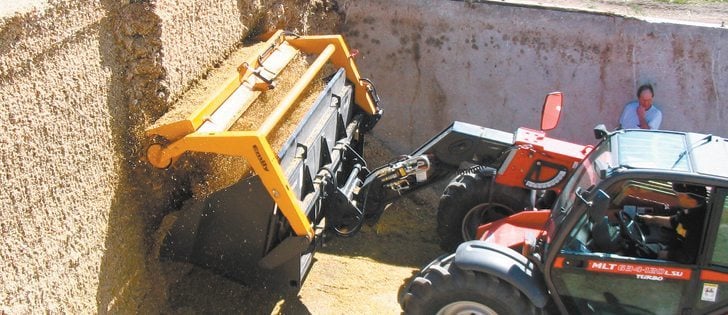Silage packing left intact | Slicing off thin layer reduces deterioration and breaks up hard clumps
RIVER HILLS, Man. — Spoilage from air in silage is one of the biggest enemies of dairy producers and small feedlot operators.
However, air penetration can be avoided by giving the silage face a clean shave at every feeding, says Kara Burrell of Agromec Industries in Brandon.
Pulling apart the face of a silage pile with grapples and buckets disturbs the remaining silage and opens up avenues for air to enter. The greater the disturbance, the more air enters the material and the more spoilage occurs.
Read Also

Farm groups ask feds for export sales reporting
The Agricultural Producers Association of Saskatchewan and SaskCrops asks the federal government to create an Export Sales Reporting program.
It’s not a problem for large feedlots, which use up their piles quickly, but it can be a significant financial loss for dairy producers and beef producers with small feedlots.
However, Burrell said a relatively small investment in the right technology can fix the problem.
She said her family-owned business has a proven solution in the silage defacer bucket it imports from France. The Emily Mobile Rotor Bucket was engineered specifically to minimize pile disturbance.
“The Emily defacer doesn’t push the bucket into the silage. It actually shaves off a uniform layer and tosses it into the bucket,” Burrell said.
“The operator brings the bucket up to the silage face, then stops. When you start the rotor, it reaches out in an arc in front of the bucket and starts trimming off a thin layer of silage. The bucket remains in that position until it’s full.”
Watching the rotor in action gives the impression that it’s spinning backward because it pulls and throws the silage over the top instead of slinging it under the rotor.
“The rotor spins backwards like that so it fills all the way to the back of the bucket,” Burrell said.
“You don’t want to waste time and money driving around with a half-full bucket.”
The rotor has short square knives that act on the pile like an electric shaver works on a human beard.
“The benefit of this smooth face is that the packing you did last summer and fall remains intact and the silage is protected until you feed it,” she said.
“We’ve had dairy farmers tell us that if their Emily defacer goes down and they have to go back to their old feeding methods, milk production deteriorates in just two days. Another benefit is that the rotor pulls apart any chunks or hard clumps. Everything that’s thrown into the bucket is fluffy and easy to mix or feed directly.”
The spinning rotor is mounted to hydraulic arms that automatically move it down the face of the pile. The gradual rate of the arms’ descent is tuned to the hydraulics of each individual tractor. It’s always set so that one pass of the rotor will equal one full bucket of silage.
“There might be a certain silage load that’s heavier and puts too much strain on the system so the rotor speed slows down,” Burrell said.
“If that happens, the hydraulics sense the extra pressure and the arms slow down and the rotor catches up. The rotor doesn’t fall as fast, but the rotor stays up to speed. It’s all part of the closed synchronized hydraulic system. It’s a simple system, just one hydraulic circuit and the requirement is only 50 litres per minute.”
The single hydraulic motor is located at the left, inside the rotor, to keep it out of the way. Each unit comes complete with the bucket, arms, rotor, hydraulics and connections.
If the front hydraulics are not adequate to handle both the lift and motor at the same time, it’s an easy matter to hook up to a rear hydraulic circuit.
The Emily Mobile Rotor Bucket is available in small sizes suitable for skid steer loaders priced at $7,000 as well as high capacity units suitable for front-end loaders and telehandlers priced at $12,000.
“We can install the Mobile Rotor Bucket on any kind of front loader machine, but it’s really intended for telehandlers. That’s how it works best,” she said.
For more information, visit www.agromecindustries.com.
















